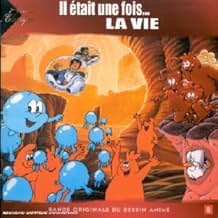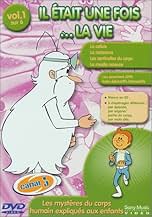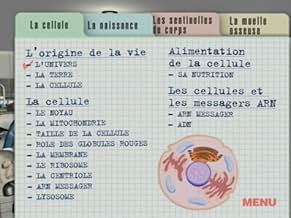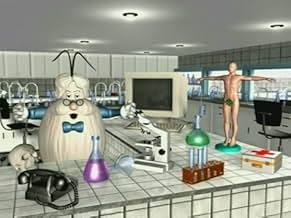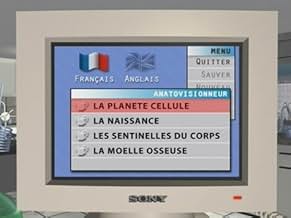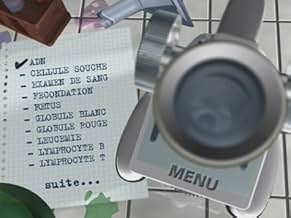Il était une fois... la vie
- Série télévisée
- 1987–1988
- Tous publics
- 30min
NOTE IMDb
8,2/10
5,7 k
MA NOTE
Cette série raconte de façon ludique le fonctionnement du corps humain et est destinée aux enfants et aux adultes.Cette série raconte de façon ludique le fonctionnement du corps humain et est destinée aux enfants et aux adultes.Cette série raconte de façon ludique le fonctionnement du corps humain et est destinée aux enfants et aux adultes.
- Récompenses
- 1 victoire au total
Parcourir les épisodes
Histoire
Le saviez-vous
- Versions alternativesAspect Ratio is changed from it's original 1.33:1 to 1.66:1 in remastered versions for TV and Digital Plaforms.
- ConnexionsFeatured in Fan des années 80: 1986 #1 (2010)
Commentaire à la une
"Make our children want to know, arouse their curiosity. Also treat them as people in their own right, who understand much more than adults would have us believe. They will be all the stronger for it and be grateful to you."
Thank you for these true words of wisdom, Monsieur Albert Barillé, and thank you for having enriched our knowledge with the "Once Upon a Time" series, whose 'Life' segment remains the greatest chapter. Rest in peace, sir, your legacy is intact, as most children of the 80's and 90's, owe you a part of their knowledge, and for some, vocations.
Now, this review must start somewhere, so how about the opening credits intro? Seriously, can you imagine today a cartoon starting with naked man and woman embracing, and then merging into a ball exploding in a blaze of flashing glory, like a mini-big-bang whose result is a baby, then a boy, then a man all, naked.
In my recent review of another 80's cartoon, I was wondering about the reactions these shows aimed for children would meet today. We live in an era of paradox where kids are constantly confronted to sexualized stuff, yet their eyes have to be covered from harmless sights of nudity with no affect whatsoever on the minds, if you dare to respect their intelligence (as Albert Barillé said: "treat them as people in their own right")
But as far as edutainment goes, this is "Dora the Explorer" era, PC days, and there is no room for shows like "Once Upon a Time Life", which not only respects children's intelligence, but makes an extraordinary effort to develop it and nurture it. God, how times have changed in less than 30 years. But there's more to say about "Once Upon a Time Life" than nudity.
After the first opus about 'Man' and 'Space', the series tackles the human body, using the same gallery of characters, starting with the inevitable Maestro, the manager of the brain and any cell nucleus (where he appears seated and surrounded by two assistants). There are also Peter and Psi, the lead protagonists whose appearances vary from kids to adults following the episode (inside the body they're part of the Lymphocites team as vessels pilots). And I just realized that Dora looked like a younger version of Psi (coincidence or homage?).
In the bad-guys area, you have the pathogens who appear as blue muscular bullies (bacteria) or worm-like creatures (viruses), they all have alter-egos in real-life, like the good guys, and a few other protagonists who deserve a mention, such as a fat kid and a blonde loving mother. And it's generally in Peter's body that the show is lead.
And to make the learning process easier, the animation strikes for its wonderful use of metaphorical imagery: enzymes are working men with baseball cap, red globules are walking creatures carrying bubbles of oxygen (and that's how I learned that blood carried air) and then carbon dioxide (their red looks darker then). The organic molecules are priceless: salts look like saltcellar, proteins like muscular characters, vitamins as colored letters or sugars as candies; police patrol for the antibodies etc.
But don't take it as a 'Human Body for Dummies' phenomenon; its target is less the 'dumbness' of adults than the intelligence of children. I was 8 when I first saw the 'birth' episode and I asked my dad, if the father has something to do with making the baby. He asked me whether I find it logical or not. Actually, it did make sense and it was enough a discovery ("Look Who's Talking' would complete my knowledge later) In the second episode, I was already conquered by the show and decided I would never miss any episode. And I enjoyed it even more because it was the Friday series, so I was twice happy to watch it.
Which episodes do I still remember? The about teeth and how each candy eaten by the little girl gave more material to the bacteria to dig in the tooth. I also learned in the bones' episode that sunshine could heal a fracture, by providing D-vitamin. I enjoyed the episode about kidneys because for the first time, the show mentioned such word as 'pee-pee' and featured characters with 'strong urges', and the cartoon dealt with it so naturally. Overall, the show reflects one of the most exciting things about childhood; learning., and not just educational things.
One day, I felt something was wrong with me, because I wanted to cry during a happy moment, a few months later, an episode was aired where Peter, who just found his dog, started crying of joy, I knew there was nothing wrong with me, it was 'natural'. The series made me discover more than the human body, it was really about 'life' in the most generic meaning: a matter of health, nature and emotions. God, I wish there could be some cartoons like this today, especially now that edutainment has been reduced to preschool and interactive shows.
This was the Golden Age of TV animated series where each one was followed like an institution, we couldn't tape every episode, there was no Youtube, no DVD, not many re-runs and when a show stopped, it had some disturbing permanent feel. This is how memorable any show's finale was, and "Once Upon a Time Life" was no exception. Obviously, what should be the last chapter of a series about life other than an episode centered on the last hours in an old man's body where every vital power was slowly fading out.
Thankfully, the episode didn't end on that depressing note and featured a birth to suggest the idea that life, like a show, must go on. As this show must go on, and on, for as long as there will be men, there will be children, and a need for knowledge to fulfill.
Thank you for these true words of wisdom, Monsieur Albert Barillé, and thank you for having enriched our knowledge with the "Once Upon a Time" series, whose 'Life' segment remains the greatest chapter. Rest in peace, sir, your legacy is intact, as most children of the 80's and 90's, owe you a part of their knowledge, and for some, vocations.
Now, this review must start somewhere, so how about the opening credits intro? Seriously, can you imagine today a cartoon starting with naked man and woman embracing, and then merging into a ball exploding in a blaze of flashing glory, like a mini-big-bang whose result is a baby, then a boy, then a man all, naked.
In my recent review of another 80's cartoon, I was wondering about the reactions these shows aimed for children would meet today. We live in an era of paradox where kids are constantly confronted to sexualized stuff, yet their eyes have to be covered from harmless sights of nudity with no affect whatsoever on the minds, if you dare to respect their intelligence (as Albert Barillé said: "treat them as people in their own right")
But as far as edutainment goes, this is "Dora the Explorer" era, PC days, and there is no room for shows like "Once Upon a Time Life", which not only respects children's intelligence, but makes an extraordinary effort to develop it and nurture it. God, how times have changed in less than 30 years. But there's more to say about "Once Upon a Time Life" than nudity.
After the first opus about 'Man' and 'Space', the series tackles the human body, using the same gallery of characters, starting with the inevitable Maestro, the manager of the brain and any cell nucleus (where he appears seated and surrounded by two assistants). There are also Peter and Psi, the lead protagonists whose appearances vary from kids to adults following the episode (inside the body they're part of the Lymphocites team as vessels pilots). And I just realized that Dora looked like a younger version of Psi (coincidence or homage?).
In the bad-guys area, you have the pathogens who appear as blue muscular bullies (bacteria) or worm-like creatures (viruses), they all have alter-egos in real-life, like the good guys, and a few other protagonists who deserve a mention, such as a fat kid and a blonde loving mother. And it's generally in Peter's body that the show is lead.
And to make the learning process easier, the animation strikes for its wonderful use of metaphorical imagery: enzymes are working men with baseball cap, red globules are walking creatures carrying bubbles of oxygen (and that's how I learned that blood carried air) and then carbon dioxide (their red looks darker then). The organic molecules are priceless: salts look like saltcellar, proteins like muscular characters, vitamins as colored letters or sugars as candies; police patrol for the antibodies etc.
But don't take it as a 'Human Body for Dummies' phenomenon; its target is less the 'dumbness' of adults than the intelligence of children. I was 8 when I first saw the 'birth' episode and I asked my dad, if the father has something to do with making the baby. He asked me whether I find it logical or not. Actually, it did make sense and it was enough a discovery ("Look Who's Talking' would complete my knowledge later) In the second episode, I was already conquered by the show and decided I would never miss any episode. And I enjoyed it even more because it was the Friday series, so I was twice happy to watch it.
Which episodes do I still remember? The about teeth and how each candy eaten by the little girl gave more material to the bacteria to dig in the tooth. I also learned in the bones' episode that sunshine could heal a fracture, by providing D-vitamin. I enjoyed the episode about kidneys because for the first time, the show mentioned such word as 'pee-pee' and featured characters with 'strong urges', and the cartoon dealt with it so naturally. Overall, the show reflects one of the most exciting things about childhood; learning., and not just educational things.
One day, I felt something was wrong with me, because I wanted to cry during a happy moment, a few months later, an episode was aired where Peter, who just found his dog, started crying of joy, I knew there was nothing wrong with me, it was 'natural'. The series made me discover more than the human body, it was really about 'life' in the most generic meaning: a matter of health, nature and emotions. God, I wish there could be some cartoons like this today, especially now that edutainment has been reduced to preschool and interactive shows.
This was the Golden Age of TV animated series where each one was followed like an institution, we couldn't tape every episode, there was no Youtube, no DVD, not many re-runs and when a show stopped, it had some disturbing permanent feel. This is how memorable any show's finale was, and "Once Upon a Time Life" was no exception. Obviously, what should be the last chapter of a series about life other than an episode centered on the last hours in an old man's body where every vital power was slowly fading out.
Thankfully, the episode didn't end on that depressing note and featured a birth to suggest the idea that life, like a show, must go on. As this show must go on, and on, for as long as there will be men, there will be children, and a need for knowledge to fulfill.
- ElMaruecan82
- 12 oct. 2015
- Permalien
Meilleurs choix
Connectez-vous pour évaluer et suivre la liste de favoris afin de recevoir des recommandations personnalisées
- How many seasons does Il était une fois... la vie have?Alimenté par Alexa
Détails
Contribuer à cette page
Suggérer une modification ou ajouter du contenu manquant

Lacune principale
What is the Canadian French language plot outline for Il était une fois... la vie (1987)?
Répondre
